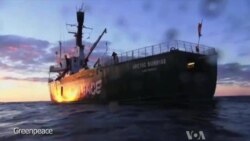SALEKHARD, RUSSIA —
Icy blasts of water greeted Greenpeace protesters climbing Russia’s lone offshore oil platform in the Arctic.
Then, Russian police fired warning shots.
And then arrested 30 activists.Today, 28 Greenpeace activists and 2 journalists from the ship are serving 2 months detention terms in Murmansk, where their ship, the Arctic Sunrise, also is impounded.
Greenpeace Russia lawyer Anton Beneslavski says last year there were no legal penalties after Greenpeace boarded the same platform and unfurled a protest banner.
He said that last year, border police never reacted. This year, police are accusing Greenpeace of piracy.
But Russia is increasingly flexing its muscles in its vast Arctic region.
In September, Russia’s only nuclear-powered guided missile cruiser led a flotilla to the Novosibirsk Islands, where Russian soldiers reopened a military base that had been closed 20 years ago.
As Arctic ice melts more, the base will check on ships passing in summer.
Last summer, China’s first icebreaker, the Snow Dragon, made the Arctic passage. This summer, the first Chinese freighter passed over the top of Russia.
Last May, at a meeting in Sweden, the Arctic Council admitted China as an observer.
That meeting also drew Greenpeace protesters. They called for a ban on drilling and mining in the fragile Arctic environment.
Recently, at Salekhard, a Russian city on the Arctic Circle, Russian President Vladimir Putin spoke at an Arctic Forum. He rejected Greepeace's protest tactics.
He said: "They are obviously not pirates, but formally, they did attempt to board the platform.”
After Putin spoke, Vera Orlova of the Russia Geographical Society told foreign reporters that their permits to visit the Russian Arctic had expired.
She said that it was an absolutely normal procedure for reporters to receive permits to visit Salekhard for only the two days of the conference.
No other nation restricts visits to its Arctic cities. But Putin’s Russia is taking the road of more and more government controls.
Then, Russian police fired warning shots.
And then arrested 30 activists.Today, 28 Greenpeace activists and 2 journalists from the ship are serving 2 months detention terms in Murmansk, where their ship, the Arctic Sunrise, also is impounded.
Greenpeace Russia lawyer Anton Beneslavski says last year there were no legal penalties after Greenpeace boarded the same platform and unfurled a protest banner.
He said that last year, border police never reacted. This year, police are accusing Greenpeace of piracy.
But Russia is increasingly flexing its muscles in its vast Arctic region.
In September, Russia’s only nuclear-powered guided missile cruiser led a flotilla to the Novosibirsk Islands, where Russian soldiers reopened a military base that had been closed 20 years ago.
As Arctic ice melts more, the base will check on ships passing in summer.
Last summer, China’s first icebreaker, the Snow Dragon, made the Arctic passage. This summer, the first Chinese freighter passed over the top of Russia.
Last May, at a meeting in Sweden, the Arctic Council admitted China as an observer.
That meeting also drew Greenpeace protesters. They called for a ban on drilling and mining in the fragile Arctic environment.
Recently, at Salekhard, a Russian city on the Arctic Circle, Russian President Vladimir Putin spoke at an Arctic Forum. He rejected Greepeace's protest tactics.
He said: "They are obviously not pirates, but formally, they did attempt to board the platform.”
After Putin spoke, Vera Orlova of the Russia Geographical Society told foreign reporters that their permits to visit the Russian Arctic had expired.
She said that it was an absolutely normal procedure for reporters to receive permits to visit Salekhard for only the two days of the conference.
No other nation restricts visits to its Arctic cities. But Putin’s Russia is taking the road of more and more government controls.










